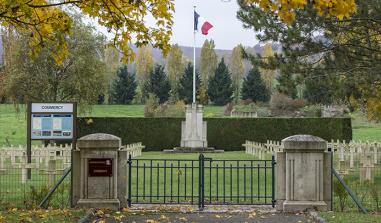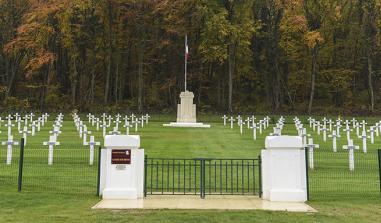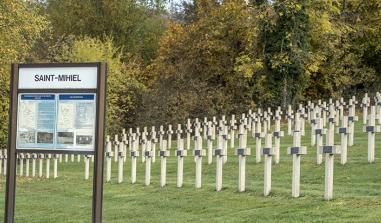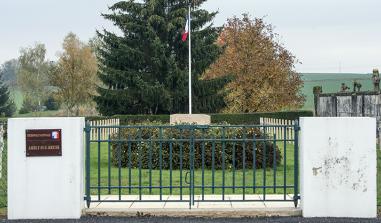Destroyed village of Bezonvaux

Destruction du village. Source : Great War Forum
February 1916: caught between the German attack aiming at Douaumont and the voluntary retreat of la Woèvre, the village could not be held.
Bezonvaux stood at the foot of the hillside along the Meuse. In February 1916, caught between the main German attack aiming at Douaumont and the voluntary retreat of la Woèvre, the village could not be held. Afterwards, Bezonvaux remained in the combat zone and shelling gradually wiped the village out completely, even though it was of no strategic interest.
Bezonvaux stood at the foot of the hillside along the Meuse. In February 1916, caught between the main German attack aiming at Douaumont and the voluntary retreat of la Woèvre, the village could not be held. Afterwards, Bezonvaux remained in the combat zone and shelling gradually wiped the village out completely, even though it was of no strategic interest.
Population in 1803: 199 1851: 317 1901:173 Distances : 10 kilometres east-northeast of Charny sur Meuse 16 kilometres north-northeast of Verdun Post office: Ornes Maucourt tax office, Ornes annex Patron saint's feast day, 1st September (Saint Gilles) Bezonvaux stood on the floor of a valley surrounded by wooded hillsides and at the source of a stream called the Bezonvaux, a sub-tributary of the Orne. The community's population was much bigger once. In August 1252, La Neuveville in Besonval, along with Beaumont and Douaumont, was freed. Later, it was a sizeable seigneury owned by the dukes of Bar. Bezonvaux depended on the lord of Saulcy for a long time before coming into the possession of the lord of Etain. It was also the administrative seat of an eponymous provosty including Beaumont, Bezonvaux and Douaumont that belonged to the sovereign court of Nancy. Ca. 1750, the population included 20 heads of families. The baron of Coussey and the ladies of Juvigny were its lords then. In 1789, the abbess of Juvigny had the high seigneury and collected all the tithes. Industries: beekeeping, grains, livestock. (Excerpt from Géographie du département de la Meuse - H. LEMOINE-1909) In 1913, the directory of the Meuse gave the following information: 149 inhabitants - Land area: 923 hectares Distances: Muraucourt, a farm 600 metres away, 8 inhabitants; the mill, 150 metres away, 4 inhabitants Innkeepers: Mr. Nivromont - Widow Remoiville Beekeepers: Mssrs. Richard - Godfrin - Nivromont (mayor) - Savion Pierre. Tobacconist: Mr. Nivromont. Carpenters: Mssrs. Grenette E. - Grenette A. Bread merchant: Mr. Nivromont Grocer: Mr. Nivromont. Laundry women: Mrs. Lamorlette and Mrs. Trouslard. Pig dealer: Mr. Léonard. Sheep and cattle dealer: Mr. Féré G. Landowning farmers: Mr. Mathieu E. - Widow Trouslard-Mathieu - Trouslard E. Notables and persons of independent means: Mssrs. Gabriel N. - Lamorlette P - Savion P. - Wyns J.B. Lady of the Manor: Mrs. Trouslard (widow).
In September 1914, the 67th division held the front in this area; Ornes, Vaux and Abaucourt were behind French lines. In late 1914 and in 1915, the Germans, who occupied Ornes, shelled Bezonvaux on and off until the attack on 21 February 1916. On 24 February 1916, Ornes was still outside the battle but incessant attacks on the village began at 7 a.m. At approximately 5 p.m., the Germans massed opposite the village, straddling the road between Ornes and Chambrettes. At 6 p.m., squeezed on three sides, the garrison evacuated Ornes and reached Bezonvaux, where the 44th IR, which had dug in on the Bezonvaux front in Maucourt Wood, was located. After La Woëvre withdrew, the Germans appeared on the Bezonvaux road, Chemin de Douaumont, the artillery barrage that isolated the village facilitating their advance. The makeshift defences fell one after the other. On 25 February 1916, the 4th LIB and 44th IR desperately held out in the village. The Germans stepped up their attack and, at approximately 5 p.m., the line broke, with the battalion defending the village in hand-to-hand, house-by-house fighting. The Germans gradually tightened the noose and at dusk, after killing nearly all the defenders, took Bezonvaux. Douaumont Fort had fallen on the same day. The French troops withdrew to Fleury. From March to July the German troops, driven by an iron will, tried to cross the heights separating them from Verdun. They advanced more slowly than the general staff had expected and the line was stabilized from mid-July onward. It should be pointed out that at the same time, the Battle of the Somme was monopolising reserves of men and munitions.
The inhabitants discovered the destructiveness of modern warfare as early as the beginning of 1916. Their homes destroyed, their only choice was to leave. Hopes of "going home one day" gave them the strength to face the heartwrenching decision to abandon their property. For these men and women were fiercely attached to their land, which was not very generous and required hard work but was nevertheless that of their roots. The prospect of going back home one day was a precious source of support for these wretched refugees. Unfortunately, the reality in 1918 was quite different. The destruction was too widespread and the threat of unexploded munitions too great to allow rebuilding. This desolate landscape could no longer be a welcoming haven. In their deep distress they had nothing left but the possibility of working for national recognition and the survival of their village if only judicially. They pressured local officials, members of parliament and ministers, even speaking to President Raymond Poincaré, who was born in the Meuse region. Their efforts were successful. In 1919, a law endowed each destroyed village with a municipal commission and a chairman who had the same powers and prerogatives as a mayor. A chapel-shelter and, as in every village, town and city in France, a monument to the dead were built between the world wars. The monument was engraved with the names of native sons who had given their lives for their country and with the text of the army citation that the government awarded by decree. Three times a day, the tolling angelus recalls that the villagers who once lived in this forested site studded with stones of remembrance were deeply Christian.
On 24 October, General Mangin launched an admirably planned attack that took back Thiaumont, the fort and village of Douaumont as well as the village and battery of Damloup. A few days later, French troops entered Vaux Fort, which the Germans had just evacuated. The success of this operation, but also its incomplete nature, led the French military leaders to contemplate repeating such an attack with a limited objective on a front approximately 10 kilometres long. The date chosen was 15 December. Communications with the rear were re-established and the work necessary for setting up a sufficient number of guns was carried out. On 10 December the French began a fierce artillery barrage to soften up the German positions. At 10 a.m. on 15 December, French troops stormed the German lines from Vacherauville to Eix. Four of the French army's best divisions took part in the assault, in this order: the 126th, 38th, 37th and 133rd. In particular, three distinguished regiments making up the infantry of the 37th division - the 2nd and 3rd Zouaves and the 3rd Algerian Tirailleurs - left Douaumont Fort in the east, advancing all day long through snow, mud and barbed wire networks towards the front. Many soldiers ended up with frostbite. The attack started again at 2 a.m. on the 16th. The goal was to take Bezonvaux. The assailants captured two key points - Liubeck's fortification and the Kaiserslautern trench - before killing many Germans. Then the Zouaves met up with the chasseurs of the 102nd battalion belonging to the 133rd division. These brave men had reached the edge of the village on the previous day; however, the sizeable number of defenders and the organisation of the ruins blocked their advance. Despite a French artillery error and fierce German shelling, the French completely rid Bezonvaux of its previous occupiers. The attack did not surpass the objective set and the front in this sector remained stable for the next two years. The chapel's stained glass windows immortalise 16 December 1916, a day marked by the presence of soldiers dressed in mustard-khaki and others in sky blue side by side. After the fighting, the chasseurs of the 102nd LIB were nicknamed the "glaziers of Bezonvaux". The line, which the Germans held until the armistice on 11 November 1918, was materialized after the war by a helmeted marker set up on the departmental road that passed through the destroyed village, which died for France.
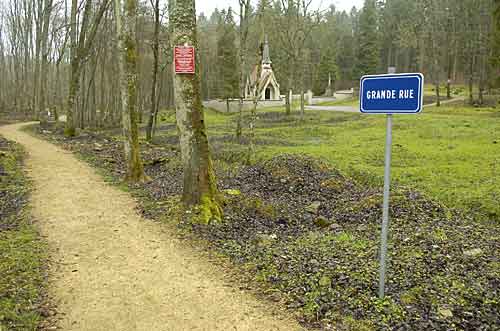
Bezonvaux - main street. Photo JP le Padellec
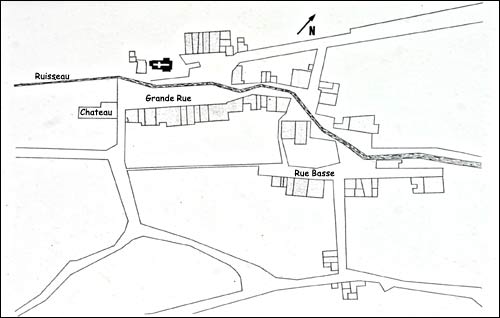
Map of the village before it was destroyed. Source: Meuse General Council
Practical information
55100
Bezonvaux
Accessible toute l'année




